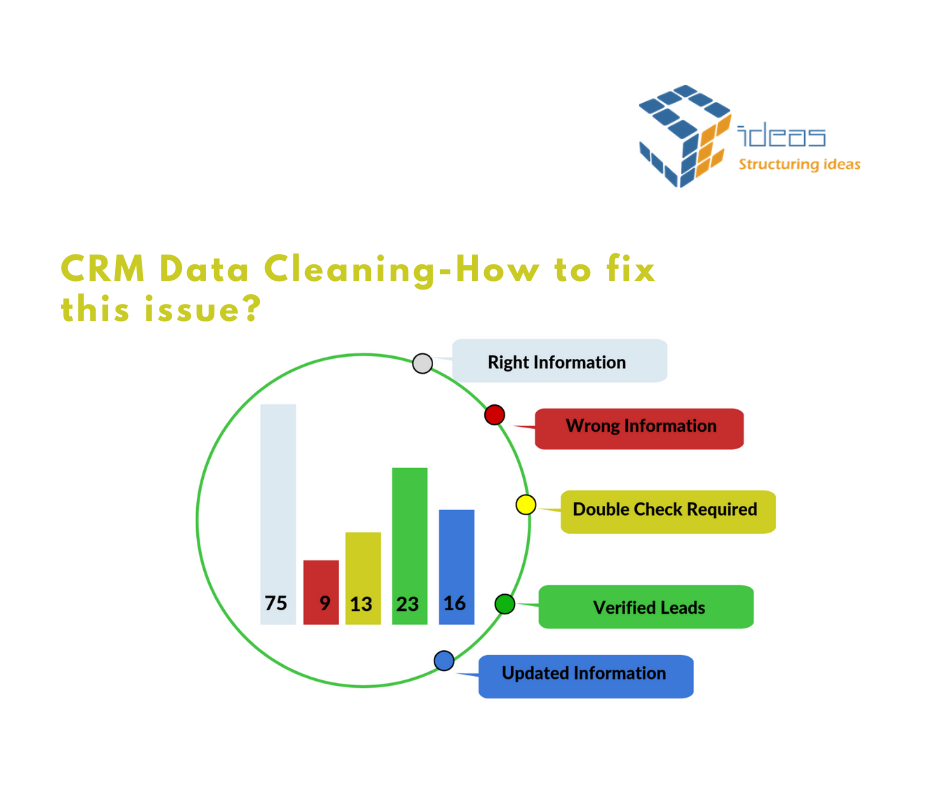Data can be useful for any business, there is certainly no doubt about that. But things can go sideways quickly if this same data becomes uncontrolled and takes the shape of irrelevant yet ever – growing abundance of information. Understand this issue with an example, suppose you have a gigantic pile of contact information, but most of this data contains invalid email IDs, duplicate, and incomplete contact data. Another problem with having these data silos is you can’t use this raw and irrelevant data in any automated process like machine learning. The only way to save this shape is to perform CRM data cleaning (aka data cleansing) on a regular basis.
Now you must be wondering why CRM (Customer Relationship Management) software only and the answer lies in the application of this software. Most CRM platforms involve businesses analyzing customer interactions, and therefore it acts as the storage unit of the entire system. A report suggests that almost 30% of company data becomes outdated after one year. Therefore, every business should learn the perfect way of cleansing their CRM software. In this article, we will share every detail that you need to know about data cleaning of CRM.
What is Data Cleaning?
In generic terms, data cleaning or data cleansing is the process of removing data that is mostly outdated, inaccurate, corrupted, and non-credible from the system. However, when it comes to CRM software, the process became a bit more complicated because here talk very specifically about how you execute your sales and marketing data of an organization.
For example, a sales team may encounter a lot of problems because the data cleaning process is not done in the way it should be. In order to grab more opportunities and leads, reps need to have access to up-to-date and credible data all the time. Data cleaning is the process of modifying data, the slightest mistake in the cleansing process can lead to catastrophic failure in the entire sales process and even collapse the system as a whole.
There are other effects as well as inefficient and longer sales cycle, sales funnels will not be performing well too. The outdated information could lead you to unworthy prospects, which means, you’ll be spending time on nurturing leads that never meant to be customers and miss on the real opportunities. All these drawbacks can be avoided by simply adapting three skills, i.e.
1 identification of corrupt/outdated data
2. Removal of unnecessary information
3. Update the current data to the latest.
“Big data is at the foundation of all the megatrends that are happening today, from social to mobile to the cloud to gaming.” This quote is more than enough to tell you the importance of data and technologies related to it like machine learning, Artificial Intelligence, Big Data, IoT (Internet of Things).
What is bad CRM Data and how to identify it?
As we mentioned earlier, almost 30% of CRM went irrelevant or outdated almost after a year. But what bad CRM data looks like and how can you identify it. In this section, we are going to unravel this. If this data piled on for a long period of time then it could start the domino effect and eventually start affecting the other business decisions as well as marketing campaigns, sales strategy, etc.
Here we are going to enlist different types of bad data that can ruin your CRM system to a great extent. There are some usual activities as well that can lead to bad CRM data if not performed in the right way, let’s have a look at them one by one.
1. Outdated Data
With every second passed, data is becoming more and more outdated. For example, people usually change their phone number, email address, physical address, job roles very frequently. So you have to keep in mind that data in your CRM should be as fresh as it possibly can be. Here are some statistics that can back the statement we just made.
2. Email Address
40% of people change their email address at least once after every two years. It means if you fail to update this information, then you are highly likely to lose a nurtured customer.
Physical Address: However this rate is lower but still 20% of people change their physical address every year.
Phone Numbers: Phones are a very important way of communication between a customer and company, therefore, it becomes crucial to keep this piece of information up-to-date. This job becomes more difficult because 18% of people change their phone numbers every year.
3. Error in spelling or typos
This mistake is committed by the customers as well as company employees. For example, if a customer visits your website and in the online form he fills out the wrong information. It will automatically save to the database, regardless of its correctness. The same scenario is plausible when an employee performs typos, which is pretty common in manual data entry.
4. Duplicate Data Points
This mostly happens when migrating data from one CRM database to another or merging two different lists. This could create confusion within the sales and marketing departments.
xhamster,
xvideos,
hentai,
porn,
tiktok download,
mp3 download,
MP3 download,
download tiktok,
hentai,
Nike Mens High Top,
youpor,
Watch Get Out,
xhamster,
xvideos,
hentai,
porn,
tiktok download,
mp3 download,
MP3 download,
download tiktok,
hentai,
Nike Mens High Top,
youpor,
Watch Get Out,
